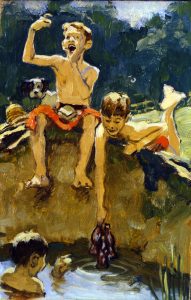Norman Rockwell Exhibition Highlights Coca-Cola History
September 11, 2012
Rockwell Exhibition Spotlights Coca-Cola History
After shattering attendance records with its debut in England, Norman Rockwell’s America, a comprehensive exhibition of the legendary illustrator’s 60-year career, opens at the Birmingham Museum of Art on September 16.
Featuring more than 52 original paintings and all 323 vintage Saturday Evening Post covers, the exhibition visually chronicles the evolving landscape of American culture and society from 1916-1969 and is one of the largest Rockwell exhibitions to ever travel.
In addition to the original exhibition, the Birmingham Museum of Art will display a supplemental collection, on loan from The Coca-Cola Company’s Archives, to highlight the historical relationship between Norman Rockwell and Coca-Cola.
Norman Rockwell created several paintings for The Coca-Cola Company between 1928 and 1935. Snyder & Black, an advertising agency, commissioned Rockwell for a series of advertisements for Coca-Cola, their most important client and America’s most visible and popular brand. For such significant commissions, Rockwell depicted moments of relaxation and leisure, choosing to be inspired by the message of an idealized lifestyle over a simple product placement.
 “Norman Rockwell and Coca-Cola are two true American classics, so we were thrilled to receive the loan from The Coca-Cola Company Archives,” says Gail Andrews, R. Hugh Daniel Director of the Birmingham Museum of Art. With this addition, visitors will enjoy learning about Rockwell’s fascinating approach to traditional commercial advertising, in which he adapted his magnificent, large-scale oil paintings to highly successful Coca-Cola advertisements.”
“Norman Rockwell and Coca-Cola are two true American classics, so we were thrilled to receive the loan from The Coca-Cola Company Archives,” says Gail Andrews, R. Hugh Daniel Director of the Birmingham Museum of Art. With this addition, visitors will enjoy learning about Rockwell’s fascinating approach to traditional commercial advertising, in which he adapted his magnificent, large-scale oil paintings to highly successful Coca-Cola advertisements.”
One featured work, entitled Three Boys Fishing, is a loosely painted conceptual study for a Coca-Cola advertisement. Highlighting a lighthearted moment of leisure, Norman Rockwell illustrates three young boys rejoicing as they ‘catch’ a bundle of Coca-Cola bottles in the pond where they are swimming and fishing. After Coca-Cola passed on the idea, Rockwell substituted the bottles for fish, and the illustration was published as the July 18, 1937 cover of The Week Magazine and subsequently for a 1939 Brown & Bigelow calendar.
“People are accustomed to hearing Rockwell described as an “illustrator,” because he created works of art for magazines, books and advertisements. Indeed, he was perhaps the greatest illustrator in history, but he wasn’t any less an artist. Behind each of his illustrations is a beautifully rendered oil painting. Rockwell was a highly skilled and extremely versatile painter,” says Graham C. Boettcher, the William Cary Hulsey Curator of American Art at the Birmingham Museum of Art. “Visitors to the exhibition may well come away with the sense that he was among the most talented American painters of the 20th century.”
Rockwell’s six-decade career depicts one of the most eventful periods in American history, spanning four wars, the Great Depression, the space race, and the Civil Rights Movement. Organized by the National Museum of American Illustration in Newport, Rhode Island, the exhibition premiered to critical and popular acclaim at London’s Dulwich Picture Gallery in December 2010.
Admission to the exhibition is free for museum members, $15 for adults, and $8 for students and children over six.
Support
Norman Rockwell’s America was organized by the National Museum of American Illustration in Newport, Rhode Island. Local presentation is made possible by Regions Bank. Additional support provided by Blue Cross and Blue Shield of Alabama, Vulcan Materials Company Foundation, the City of Birmingham, the Members and Corporate Partners of the Birmingham Museum of Art, the Alabama Tourism Board, the Alabama State Council on the Arts, and The Friends of Rockwell.
About the Birmingham Museum of Art: Founded in 1951, the Birmingham Museum of Art has one of the finest collections in the Southeast. More than 24,000 objects displayed and housed within the Museum represent a rich panorama of cultures, including Asian, European, American, African, Pre-Columbian, and Native American. Highlights include the Museum’s collection of Asian art, Vietnamese ceramics, the Kress collection of Renaissance and Baroque paintings, sculpture, and decorative arts from the late 13th century to the 1750s, and the Museum’s world-renowned collection of Wedgwood, the largest outside of England.